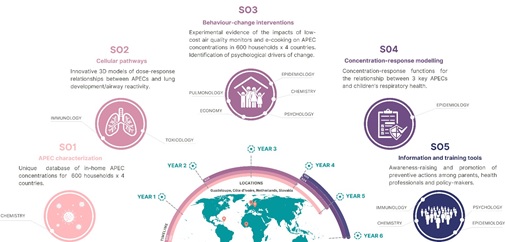- Summary :
- Background and rationale:
There is growing evidence that household environments are subject to high concentrations of air pollutants of emerging concern (APECs)(1) which are suspected to significantly affect human health. However APECs are not yet regulated due to a lack of quantitative evidence of their health impacts(2). This includes ultrafine particles (UFPs) and black carbon (BC)(3,4). In addition, airborne micro and nanoplastics (MNPs) also have high indoor-to-outdoor ratios and have recently emerged as a health concern(5). APECs are harder to characterize than most commonly studied pollutants which partly explains the scarcity of data on their health impacts. Children and adolescents are particularly vulnerable to the health effects of APECs due to the immaturity of their organs and immune system, to their specific metabolism, and to a higher ratio of inhaled air volume to body weight compared to adult subjects. Short-term exposure to UFPs is associated with decreased lung function and asthma exacerbation in children with asthma and allergies(6). Similar effects are documented for BC (7,8) and suspected for MNPs (9,10). Indoor or household residential APEC concentrations might thus contribute to the high current childhood asthma prevalence of approximately 10% in EU countries.
Indoor sources may co-emit APECs along with regulated1 air pollutants (RAPs) which are also known to have a negative impact on respiratory health (decrease in lung function, asthma exacerbation, lower tract infections), and suggested impact on the respiratory health of new-borns after in-utero exposure (11). Gas stoves for instance, which are the main cooking appliance for 20%-68.5% of the population in 13 of the 27 EU-member countries(12), emit both UFPs and NO2 among other pollutants. This points to a need to study APECs jointly with classical regulated air pollutants such as NO2 or PM2.5 in the case of asthma.
Household air pollution (HAP) is therefore a major source of population exposure to both APEC and RAPs with demonstrated or hypothesized impacts on lung health, notably in children and adolescents. HAP exposure could in particular be reduced thanks to individual behaviour change if people had access to information, to individual monitoring devices, and to alternative technical solutions to replace polluting devices. With the emergence of new tools such as low-cost sensors for user-friendly HAP measurements and recent progress in involving citizens in participatory research, there is an opportunity to develop innovative approaches based on citizen science to conduct research on the impacts and mitigation of air pollutants. Involving policy-makers and relevant professionals such as medical professions during the research phase is also key to ensure that interventions evaluated by researchers will later on be promoted and adopted by public authorities. Likewise involving populations from the Global South and from overseas EU territories where HAP has both global environmental impacts and local health impacts is essential in a time of climate change.
- Objective:
General: to assess the impact of household air pollutants of emerging concern on the respiratory health of children and adolescents, and to generate guidelines and tools which will help citizens, relevant professionals and policy-makers to act against these pollutants and related illnesses
Specific:
SO1: To provide evidence of in-home concentrations of 3 key APEC categories and relevant co-pollutants (PM2.5, NO2) in large samples (4 x 600 households) in urban areas across 4 countries with different climatic and social conditions (Côte d’Ivoire, France – overseas, Netherlands, Slovakia). [Timeline: year 1 – year 5]
SO2: To identify exposure-to-disease mechanisms for 3 key APEC categories from their fate in sputum or biopsy samples of children and adolescents to their cellular uptake and effects by developing innovative 3D cell models of dose-response relationships of individual components - alone and in combination - on lung development and airway reactivity (8 APECs: BC, 3 specific UFPs, 4 specific MNPS). [Timeline: year 1 – year 4];
SO3: To develop 2 behaviour-change interventions ((a) user-friendly air quality monitors, (b) incentives for electric cooking) targeting HAP and to evaluate their effects on exposure to APECs and on respiratory heath in children/adolescents via a randomized controlled trial (4 study sites, 2 interventions/site). [Timeline: year 2 – year 5]
SO4: To model concentration-response functions for the relationship between 3 key APECs and children’s respiratory health and to produce recommendations for the management and mitigation of APECs and other household air pollutants (1 meta-analysis per pollutant, 1 concentration-response model per pollutant, 6 expert workshops on limit values, 1 recommendation report for limit values). [Timeline: year 4 – year 6].
SO5: To develop information and training tools targeting citizens, health professionals, and policy-makers to foster the adoption of preventive actions against indoor APECs and RAPs (1 policy brief, 3 articles for professional journals, 2 massive open online courses, country-adapted awareness raising kits). [Timeline: year 4 – year 6]
- Main Methods
AIRYOUTH is a multidisciplinary project integrating several approaches to develop impactful solutions to lower the burden of air pollution-induced childhood respiratory diseases and to transfer them into policy and into citizen’s practices. It is structured around the 5 specific objectives (SO) as shown in the figure below:













